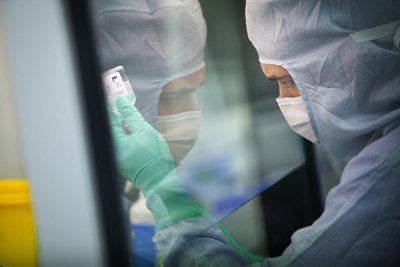Evolution of Cell and Gene Therapies and the Role of Rapid Quality Control Solutions to Ensure Safe and Effective Products
By the bioMérieux Editors | Reading time: 2 min
PUBLICATION DATE: DECEMBER 20, 2023
Featured Experts:
Félix Montero Julian, PhD, Global Scientific Director of Pharma Quality Control at bioMérieux
Thomas Jones, PhD, ATMP Business Director of Pharma Quality Control at bioMérieux
Cell, gene, and tissue-based therapies, also referred to as Advanced Therapy Medicinal Products (ATMPs), present unique opportunities to address some of the most problematic diseases, like cancer autoimmune diseases, cardiac diseases, etc., including those with limited treatment options and genetic disorders such as cystic fibrosis, thalassemia, hemophilia, and sickle cell disease. Cell therapy involves genetically engineering cells, which may be modified version of the patient’s own cells, ![]() (Autologous) or cells from a donor (Allogenic) and placing it into a patient’s body.
(Autologous) or cells from a donor (Allogenic) and placing it into a patient’s body.
Gene therapy involves modifying DNA within a patient’s cells to replace, deactivate, or introduce a gene, which can be done either inside the patient’s body or outside the body (in vitro).
In an episode of the European Pharmaceutical Review (EPR) podcast, bioMérieux experts Félix Montero Julian, PhD, Global Scientific Director of Pharma Quality Control, and Thomas Jones, PhD, ATMP Business Director of Pharma Quality Control, address the evolving cell and gene therapy (CGT) landscape and discuss how rapid analytical methods and quality testing solutions can play a vital role in ensuring the development of safe and effective products.
Recent Advancements in Cell & Gene Therapies
The CGT landscape is ever-changing as new therapies and technologies are developed and existing ones are refined. In 2022, the US Food and Drug Administration (FDA) approved lisocabtagene, maraleucel and axicabtagene ciloleucel for second-line treatment of adult patients with large B-cell lymphoma. But also ciltacabtagene autoleucel (Carvykti) for relapsed or refractory multiple myeloma, and the extension of use of tisagenlecleucel for refractory follicular lymphoma. Further studies are already underway for frontline use, which Thomas Jones, PhD, notes, could lead to a rapid increase in the number of patients that could be treated with these therapies.
Thomas Jones further explains that many pharma QC professionals have anticipated seeing frontline use of CGTs as the landscape continues to evolve and advance. Indeed, new data have been published that shows that patients with Lupus can benefit of CART cell therapy.
The approval of axicabtagene ciloleucel for second line use in large B-cell lymphoma provided relevant support for the utilization and efficacy of cellular based treatments, revolutionizing their use, and providing recognition that cell treatments are no longer being categorized as last-resort treatment options. “The efficacy of these treatments and the regulatory authority’s acknowledgement of that efficacy really bodes well for the future of the space,” says Thomas Jones.
“The Alliance for Regenerative Medicine forecasts regulatory decisions on 17 new cell and gene therapy products by the end of 2023—you can see the potential for an explosion in the number of patients that could be treated with these therapies,” he adds.
The Role of Quality Control Testing in Manufacturing of Cell and Gene Therapies
Even with these promising advancements, CGT manufacturing still faces many challenges, such as availability of fit-for-purpose analytical technologies, high costs of goods, regulatory constraints, and issues navigating manufacturing capacity and delivery times. A major component is the quality control testing that companies must do to ensure that products are safe and effective for patients—although critically important, such testing is also time-consuming and technically challenging.
Félix Montero Julian, PhD, explains that migrating to decentralized manufacturing and integrating manufacturing processes can help streamline production and reduce lead times. “Today, the manufacturing of autologous products takes about three to four weeks since the time patient cells are taken (leukapheresis) until the patient is infused with the CAR-T product. Companies are trying to reduce these lead times, going from three weeks to one week, or even a few days,” he says. This is particularly important because autologous CAR-T (chimeric antigen receptor T cell) therapies are used to treat hematological cancers, so patients are often extremely ill and represent the last time of treatment when all the current standard care are exhausted.
Cell therapy products require the full range of safety, environmental, and cellular quality attribute (CQA) tests. Safety testing includes sterility, mycoplasma and endotoxin testing to ensure a product is not contaminated. CQA testing, including identity, viability and potency tests are also critical to help ensure that patients are getting the right product at the right dose in the right manner.
However, “many of the existing solutions were developed for applications that are less time sensitive and don’t meet the needs for cell and gene therapy manufacturers,” says Thomas Jones. Newer fit-for-purpose testing solutions can help streamline the process while adhering to regulatory requirements and meeting patients’ needs.
Another element that can constrain CGT manufacturing is staffing. According to Thomas Jones, the CGT field is rapidly gaining popularity and there is already fierce competition for QC talent. Many companies have faced high turnover and a lack of qualified personnel to perform the complex testing needed to ensure the safe and efficient production of CGT treatments.
To help address the turnover and the need for qualified QC professionals, Thomas Jones suggests that making QC tests easier to use may alleviate some of the staffing issues. “As an additional benefit, because the reduction of the complexity, it reduces the chance for errors, so you wind up getting to a more consistent QC process,” he says.
Lastly, it is important to note that environmental controls can also be subject to similar constraints and should be considered. As Félix Montero Julian describes, all these products are manufactured under a GMP (Good Manufacturing Process) making each patient a batch, further increasing the number of environmental controls needed. “So, having automated integrated solutions in order to manage the reading the petri dishes and to handle the data that are generated is super important. Therapy manufacturers move from hundreds of patients to thousands – so searching for better ways to perform environmental control is critical here.”
The Future of CGT Requires Education and Research to Overcame Barriers
The continuous evolution of CGT carries the potential to revolutionize treatment for patients with limited options due to diseases that are more difficult or nearly impossible to treat. However, it is important to note that this treatment approach necessitates further research and education to overcome challenges to implementation, and to help ensure the development of safe and effective products for patients.
“This is the future of medicine…there is still a lot to do to understand the mechanism of these products,” says Félix Montero Julian. “Stay tuned – I think that the market, the technology, the science is evolving faster, and we will see and will live in extraordinary moments in this particular area.”
You may be interested in these articles
SHARE THIS ARTICLE:
- Pharmaceutical Quality Control



